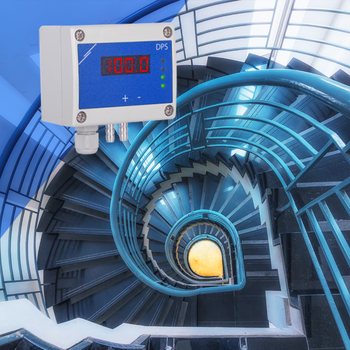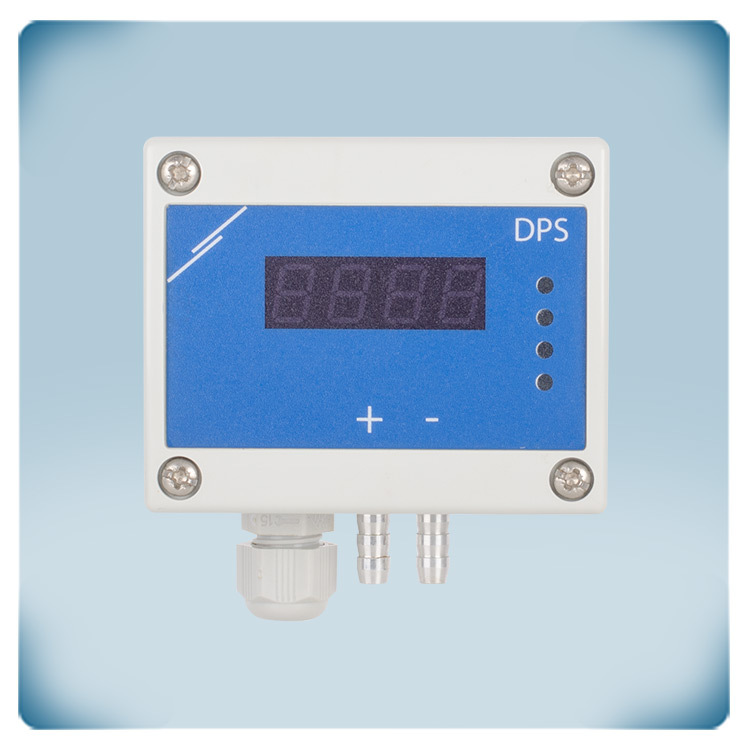EU declaration conformity
Constant pressure controller | display | -125 to 125 Pa | 24 VAC-VDC
Product description
Differential pressure controller with display for fans. A typical application is Variable Air Volume flow or VAV control. The supply voltage is 24 VAC or 24 VDC. The operating range is -125 to +125 Pa.
It controls fan speed to maintain differential pressure or air volume flow constant at the set point. Air velocity control is also possible in combination with a Pitot tube. The setpoint can be adjusted via Modbus RTU communication.
The sensor output controls EC fans, frequency inverters or AC fan speed controllers via 0-10 V. Another output type can be selected, if necessary.
The 7-segment LED display and the four LED indicators provide a clear visual indication of the device status and the controlled values.
The differential pressure setpoint and all other settings can be adjusted via Modbus RTU.
Documents
Additional specifications and description
This differential pressure controller controls EC fans or AC fan speed controllers. It maintains the differential pressure constant at the set point. The operating range is -125 to +125 Pa. It is also possible to control fan speed based on air volume flow [m³/hr] or air velocity [m/s]. To control air volume flow based on the K-factor of the fan, use the optional connection set type PSET-PVC-200 or PSET-QF-200. This connection set can also be used to control differential pressure. To control air volume flow based on the duct cross section [cm²] or air velocity [m/s], use the optional connection set type PSET-PTS-200 or PSET-PTL-200. The setpoint can be adjusted via Modbus RTU.

The 7-segment LED display visualises the measured pressure, volume flow or air velocity. On top of that, the green, yellow and red LED offer a visual indication of the measured value. The green LED indicates that the pressure level is within range. When the pressure level enters the alert range, the yellow LED lights up. Red means: differential pressure out of range. The LEDs can also visualise the status of the air volume flow or air velocity. The second green LED indicates the sensor status. It is activated when power supply and Modbus RTU communication are enabled.
This pressure controller has one analogue output. This output controls EC fans or AC fan speed controllers based on the measured differential pressure, air volume flow or air velocity. The fan speed is controlled to maintain the measured value constant at the setpoint. The setpoint can be adjusted via Modbus RTU. To make this controller compatible with most EC fans and AC fan speed controllers, the output type can be adjusted via Modbus RTU: 0-10 VDC / 0-20 mA / 0-100 % PWM. To match the reaction time of the fan to the application, P and I factors can be adjusted via Modbus RTU.
The supply voltage, the analogue output and Modbus RTU communication can be connected via the cage clamp terminal block. They eliminate the need for routine maintenance and guarantee a reliable contact for solid or stranded wires. This sensor controller can be supplied with 24 VDC or with 24 VAC. It is intended for 3-wire connection. The ground of the output (GND) is internally connected to the ground of the supply voltage (V-). Make sure not to connect this common ground to other devices that are powered by a DC voltage.
The enclosure is made of high-quality r-ABS VO (UL94) plastic. This material is heat resistant, very tough and offers good protection against impacts. The pressure connection nozzles are made from aluminium. The sensor enclosure offers an IP65 protection against ingress of dirt and water. This pressure controller can be wall-mounted.
A typical application for differential pressure controllers with this range is to maintain an under pressure or overpressure in staircases or cleanrooms.
E.g. by creating a constant overpressure in the staircase, it remains smoke-free in case of fire.







.webp)
.webp)
.webp)
.webp)
.webp)
.webp)





Remarks, reviews & ratings